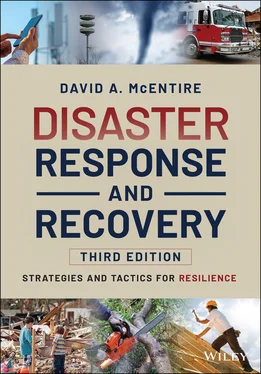David A. McEntire - Disaster Response and Recovery
Здесь есть возможность читать онлайн «David A. McEntire - Disaster Response and Recovery» — ознакомительный отрывок электронной книги совершенно бесплатно, а после прочтения отрывка купить полную версию. В некоторых случаях можно слушать аудио, скачать через торрент в формате fb2 и присутствует краткое содержание. Жанр: unrecognised, на английском языке. Описание произведения, (предисловие) а так же отзывы посетителей доступны на портале библиотеки ЛибКат.
- Название:Disaster Response and Recovery
- Автор:
- Жанр:
- Год:неизвестен
- ISBN:нет данных
- Рейтинг книги:5 / 5. Голосов: 1
-
Избранное:Добавить в избранное
- Отзывы:
-
Ваша оценка:
- 100
- 1
- 2
- 3
- 4
- 5
Disaster Response and Recovery: краткое содержание, описание и аннотация
Предлагаем к чтению аннотацию, описание, краткое содержание или предисловие (зависит от того, что написал сам автор книги «Disaster Response and Recovery»). Если вы не нашли необходимую информацию о книге — напишите в комментариях, мы постараемся отыскать её.
The new edition of the standard textbook in the field, updated with new studies and practical guidelines for reacting to the complexities of today’s disasters Disaster Response and Recovery: Strategies and Tactics for Resilience
Disaster Response and Recovery: Strategies and Tactics for Resilience, Third Edition
Disaster Response and Recovery — читать онлайн ознакомительный отрывок
Ниже представлен текст книги, разбитый по страницам. Система сохранения места последней прочитанной страницы, позволяет с удобством читать онлайн бесплатно книгу «Disaster Response and Recovery», без необходимости каждый раз заново искать на чём Вы остановились. Поставьте закладку, и сможете в любой момент перейти на страницу, на которой закончили чтение.
Интервал:
Закладка:
3 Bin O, Edwards B. (2009) Social capital and business giving to charity following a natural disaster: an empirical assessment. J Socio‐Econ, 38:601–607.
4 Birkland TA, Rath N. (2000) Business and political dimensions in disaster management. J Publ Policy, 20 (3):275–303.
5 Born P, Viscusi, WK. (2006) The catastrophic effects of natural disasters on insurance markets. J Risk Uncertain, 33:55–72.
6 Brennan MA. (2005) Community volunteers: the front line of disaster response. J Volunt Adm, 23 (4):52–56.
7 Clarke W. (2006) Emergency Management in County Government: A National Survey. Athens, GA: National Association of Counties/Carl Vinson Institute of Government, University of Georgia.
8 Deacon JB. (1918) Disasters and the American Red Cross in Dsaster Relief. New York: Russell Sage Foundation.
9 Dee G. (2014) Whole community planning: building resiliency at the local level. J Bus Contin Emer Plan, 7 (3):253–259.
10 Drabek TE, McEntire DA. (2003) Emergent phenomena and the sociology of disaster: lessons, trends and opportunities from the research literature. Disaster Prev Manage, 12 (2):97–112.
11 Dunaway WM, Shaw GL. (2010) The influence of collaborative partnerships on private sector preparedness and continuity planning. J Homel Secur Emerg Manage, 7 (1):Article 47.
12 Dynes R. (1970) Organized Behavior in Disaster. Lexington: Lexington Books.
13 Egan MJ, Tischler GH. (2010) The National Voluntary Organizations Active in Disaster relief and disaster assistance missions: an approach to better collaboration with the public sector in post‐disaster operations. Risk, Hazards Crisis Public Policy, 1 (2):Article 3.
14 Feldbush MW. (2007) The role of clergy in responding to disaster events. South Med J, 100 (9):942–943.
15 FEMA. (2012, October 25) Glossary of terms. Federal Emergency Management Agency. Retrieved August 7, 2013. Available at http://www.fema.gov/vii‐glossary‐terms. Accessed June 18, 2014.
16 Fernando M. (2007) Corporate social responsibility in the wake of the Asian tsunami: a comparative study of two Sri Lankan companies. Eur Manage J, 25 (1):1–10.
17 Ferro C, Henry D, MacLellan T. (2010) A Governor’s Guide to Homeland Security. Washington, DC: NGA Center for Best Practices.
18 Flynn DT. (2007) The impact of disasters on small business disaster planning: a case study. Disasters, 31 (4):508–515.
19 Franke ME, Simpson DM. (2004) Community response to Hurricane Isabel: an examination of community emergency response team (CERT) organizations in Virginia. Quick Response Research Report 170. Boulder, CO: Natural Hazards Center, University of Colorado.
20 Frost C. (1994) Effective responses for proactive enterprises: business continuity planning. Disaster Prev Manage, 3 (1):7–15.
21 Gazley B, Brudney JL. (2005) Volunteer involvement in local government after September 11th: the continuing question of capacity. Public Adm Rev, 65 (2):131–142.
22 Gerber BJ, Robinson SE. (2009) Local government performance and the challenges of regional preparedness for disasters. Public Perform Manage Rev, 32 (3):345–371.
23 Hamilton SE. (2005) Volunteers in disaster response: the American Red Cross. J Aggress Maltreat Trauma, 10 (1/2):621–632.
24 Hayes JK, Ebinger CK. (2011) The private sector and the role of risk and responsibility in securing the nation’s infrastructure. J Homel Secur Emer Manag, 8 (1):Article 13.
25 Henstra D. (2010) Evaluating local government emergency management programs: what framework should public managers adopt. Public Adm Rev, 70 (2):236–246.
26 Kapucu N. (2007) Non‐profit response to catastrophic disasters. Disaster Pre Manag, 16 (4):551–561.
27 Kapucu N, Augustin ME, Garayev, V. (2009) Interstate partnerships in emergency management: Emergency management assistance compact in response to catastrophic disasters. Public Adm Rev, 69 (2):297–313.
28 Kapucu N. (2012) Disaster and emergency management systems in urban areas. Cities, 29:S41–S49.
29 Kapucu N. (2015) Emergency management: whole community approach. EncyclPublic Adm Public Policy, 13 (4):1–6.
30 Kreiser M, Mullins M, Nagel JC. (2018) Federal Disaster Assistance Response and Recovery Programs: Brief Summaries. Washington, DC: Congressional Research Service.
31 Kunrether H, Roth RJ Sr. (1998) Paying the Price: The Status and Role of Insurance Against Natural Disasters in the United States. Washington, DC: Joseph Henry Press.
32 Lindstrom J, Samuelsson S, Hagerfors A. (2010) Business continuity planning methdology. Disaster Prev Manage, 19 (2):243–255.
33 Marwitz S, Maxson N, Koch B, Aukerman T, Cassidy J, Belonger, D. (2008) Corporate crisis management in a chemical facility. J Hazard Mater, 159:92–104.
34 Massey K, Sutton J. (2007) Faith community’s role in responding to disasters. South Med J, 100 (9):944–945.
35 McEntire DA, Robinson RJ, Weber RT. (2003) Business responses to the World Trade Center disaster: a study of corporate roles, functions, and interaction with the public sector. In: Beyond September 11th: An Account of Post‐Disaster Research. Special Publication #39. Boulder: Institute of Behavioral Science, Natural Hazards Research and Applications Information Center, University of Colorado. p 431–459.
36 McEntire DA. (2006) Local emergency management organizations. In: Rodriguez H, Quarantelli EL, Dynes RR, editors. Handbook of Disaster Research. Springer: New York. p 168–182.
37 Neal DM. (1992/1993) The local Red Cross in time of disaster: characteristics and conditions of organizational effectiveness during the Loma Prieta earthquake and central Texas floods. J Volunt Adm, 11 (2):6–16.
38 O’Brien P, Mileti DS. (1992) Citizen participation in emergency response following the Loma Prieta Earthquake. Int J Mass Emerg Disasters, 10 (1):71–89.
39 Olshansky RB, Johnson LA. (2015) The evolution of the federal role in supporting community recovery after U.S. disasters. J Am Plann Assoc, 80 (4):293–304.
40 Paton D. (1999) Disaster business continuity: promoting staff capability. Disaster Prev Manage, 8 (2):127–133.
41 Phillips B, Jenkins, P. (2010) The roles of faith‐based organizations after Hurricane Katrina. In: Kilmer RP, Gil‐Rivas V, Tedeschi RG, Calhoun LG, editors. Helping Families and Communities Recover from Disaster: Lessons Learned from Hurricane Katrina. Washington, DC: American Psychological Association. p 215–238.
42 Popkin RS. (1978) The American red cross response to disasters. Mass Emerg, 3:49–53.
43 Quarantelli EL. (1966) Organization under stress. In: Brictson R. editor. Symposium in Emergency Operations. Santa Monica: System Development Corp. p 3–19.
44 Quarantelli EL. (1996) Emergent behaviors and groups in the crisis time of disaster. In: Kwan KM, editor. Individuality and Social Control: Essays in Honor of Tamotsu Shibutani. Greenwich, CT: JAI Press. p 47–68.
45 Rapaport C, Kirschenbaum A. (2008) Business continuity as an adaptive social process. Int J Emerg Manage, 5 (3/4):338–347.
46 Robinson SE, Gerber BJ. (2007) A seat at the table for nondisaster organizations. Public Manag, 36 (3):4–6.
47 Robinson SE, Murphy H. (2014) Frontiers in the study of nonprofit organizations in disasters. Risk, Hazards Crisis Public Policy, 4 (2):128–134.
48 Rodriguez H, Trainor J, Quarantelli EL. (2006) Rising to the challenges of a catastrophe: the emergent and prosocial behavior following Hurricane Katrina. Ann Am Acad, 604:82–101.
49 Ross JL. (1970) The Salvation Army: emergency operations. Am Behav Sci, 13:404–413.
50 Sanchez JI, Korbin WP, Viscarra DM. (1995) Corporate support in the aftermath of a Natural disaster: effects on employee strain. Acad Manag J, 38 (2):504–521.
51 Sherman AL, Green RA, Brissett MK. (2006) Being There: Faith on the Frontlines. Charlottesville, VA: Sagmore Institute for Policy Research.
Читать дальшеИнтервал:
Закладка:
Похожие книги на «Disaster Response and Recovery»
Представляем Вашему вниманию похожие книги на «Disaster Response and Recovery» списком для выбора. Мы отобрали схожую по названию и смыслу литературу в надежде предоставить читателям больше вариантов отыскать новые, интересные, ещё непрочитанные произведения.
Обсуждение, отзывы о книге «Disaster Response and Recovery» и просто собственные мнения читателей. Оставьте ваши комментарии, напишите, что Вы думаете о произведении, его смысле или главных героях. Укажите что конкретно понравилось, а что нет, и почему Вы так считаете.












